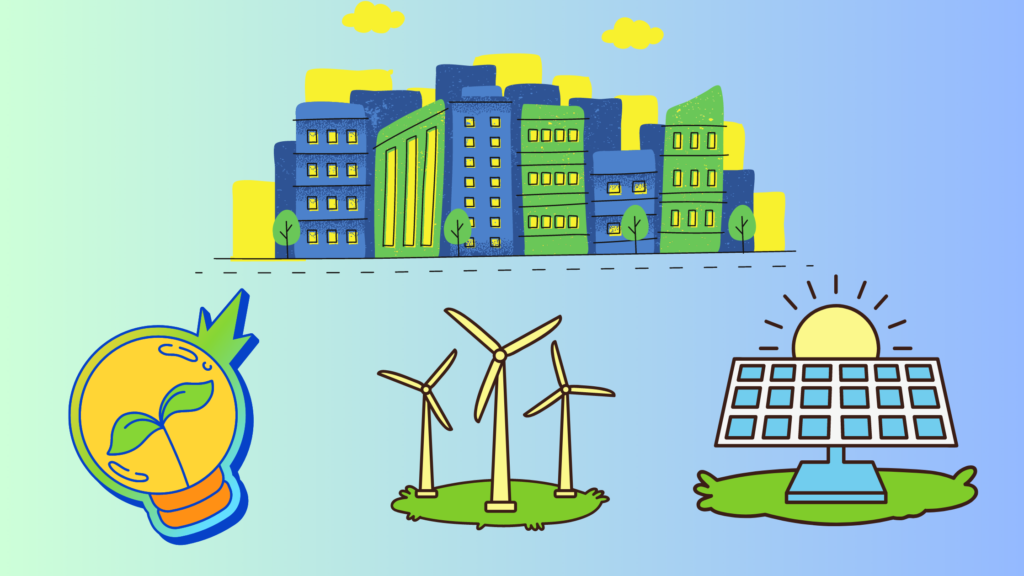
Introduction
Green energy, derived from renewable sources with minimal environmental impact, is gaining momentum worldwide as a solution to combat climate change and reduce pollution. In recent years, there has been a growing awareness of the urgent need to move away from traditional fossil fuels and embrace cleaner, more sustainable alternatives. Green energy conversion has emerged as a crucial solution utilizing innovative technologies that harness renewable resources for electricity, heat and fuel This article explores the exciting advancements in green energy conversion and their potential to revolutionize our energy landscape.
What is Green Energy?
- Solar Power: Harnessing the abundant energy from the sun, solar power utilizes panels to convert sunlight into electricity. We discuss the decreasing costs, growing effeciency, and versatile applications of solar power in various settings.
- Wind Power: Wind turbines capture the kinetic energy of the wind and convert it into electricity. We explore the growth of onshore and offshore wind farms, advancements in turbine technology, and the potential for wind power to become a dominant energy source.
- Hydropower: Hydropower generates electricity by harnassing the force of flowing or falling water. We discuss different forms, environmental considerations, contributions to energy grids, and emerging technologies for improved efficiency.
- Biomass Energy: Using organic materials, such as agricultural waste and wood, biomass energy generates heat, electricity, and biofuels. We explore biomass conversion processes, waste reduction potential support for rural communities, and its role as a sustainable alternative to fossil fuels.
- Geothermal Energy: Geothermal energy taps into the heat beneath the Earth’s surface for electricity, heating, and cooling. We discuss geothermal power plants, heat pumps, and the benefits of reliability, low environmental impact, and baseload power provision.
- Tidal and Wave Energy: Tidal and wave energy harness the power of ocean tides and waves to generate electricity. We explore different technologies, implementation challenges, and the potential of these sources in the green energy mix.
The Evolution of Energy Conversion
- The Rise of Renewable Resources: This section highlights the increasing importance of renewable resources such as solar, wind, hydro, geothermal, and biomass energy. These resources have become essential in the green energy revolution due to their abundance and minimal environmental impact. We explore their unique features, scalability, and how they can reshape our energy systems.
- Solar Energy Conversion: Solar power takes the lead in the green energy movement. This section discusses the progress made in solar energy conversion technologies. From traditional solar panels to advanced solar thermal systems, we explore improvements in efficiency, cost reduction, and integration possibilities that have propelled solar power to the forefront of green energy generation.
- Wind Energy Conversion: Wind power has experienced remarkable growth in recent years. This section highlights the advancements in wind energy conversion technologies. We explore the development of more efficient wind turbines, offshore wind farms, and solutions for intigrating wind power into the electricity grid, making it a viable and cost-effective option for generating electricity.
- Hydro, Geothermal, and Biomass Energy Conversion: This section explores lesser-known green energy conversion technologies. We discuss harnessing the power of water through hydroelectricity utilizing geothermal resources for heating and electricity and converting biomass into renewable energy sources. Each of these technologies presents unique opportunities for sustainable energy generation.
- Energy Storage and Grid Integration: Effective energy storage and seamless integration with existing power grids are crucial for the success of green energy conversion. In this section, we explore advancements in energy storage technologies such as batteries, pumped hydro storage, and emerging options like hydrogen storage. We also examine the challenges and solutions associated with integrating intermittant renewable energy sources into the grid.
- The Future of Green Energy Conversion: In the final section, we discuss the potential impact of green energy conversion on the global energy landscape. We explore the benefits of reducing carbon emissions, enhancing energy security, and creating job opportunities. Additionally, we emphasize the importance of policy support, investment, and international cooperation to accelerate the global transition to green energy conversion.
Conclusion:
As we confront the challenges posed by climate change and depleting fossil fuel reserves, green energy conversion offers a promising way forward. This article showcases the remarkable advancements in renewable energy technologies and their potential to transform the way we generate, store, and distribute energy. By embracing green energy conversion, we can build a sustainable future and safeguard our planet for generations to come.